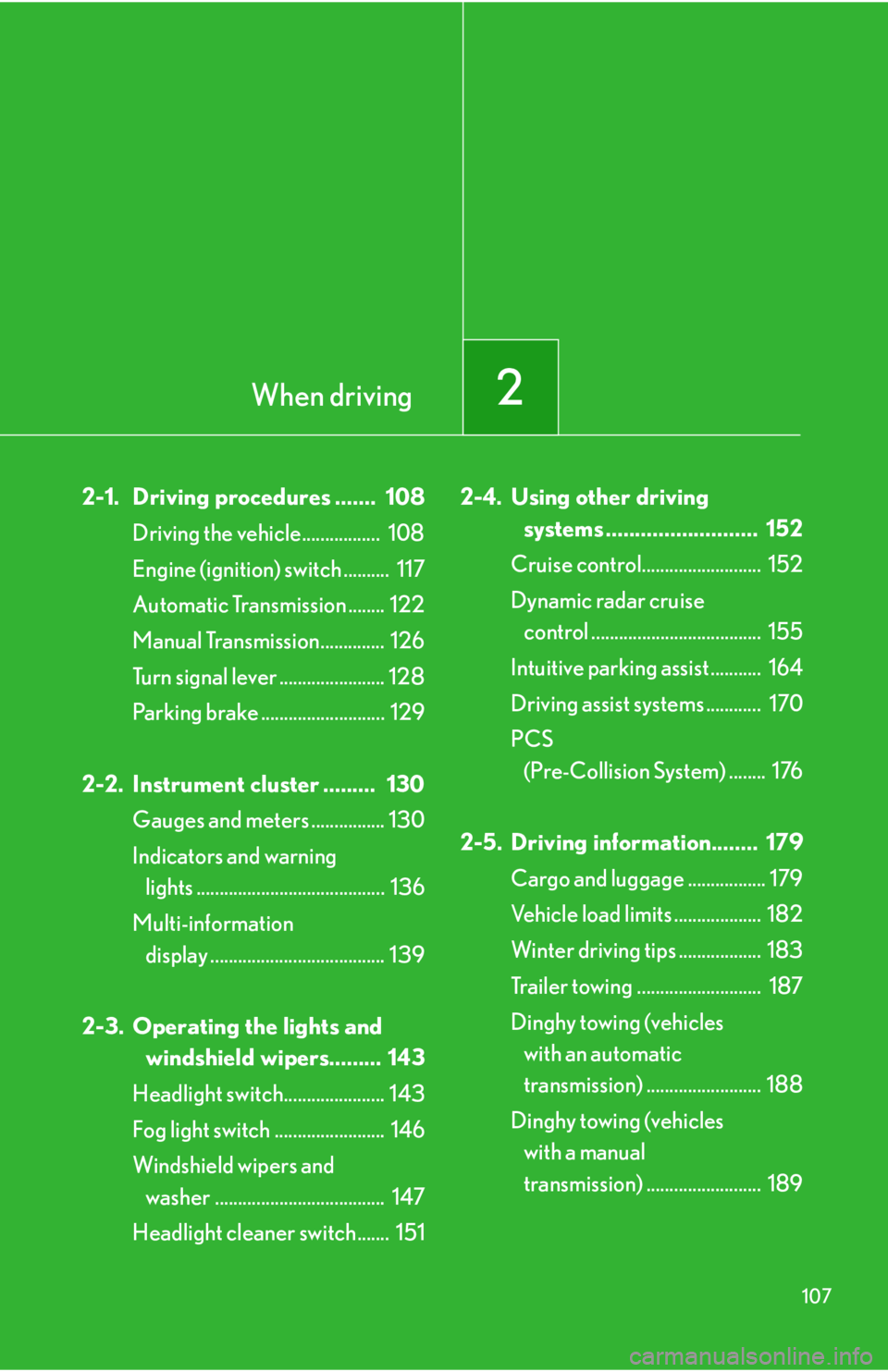towing Lexus IS250 2008 Using the air conditioning system and defogger / LEXUS 2008 IS250 OWNER'S MANUAL (OM53699U)
[x] Cancel search | Manufacturer: LEXUS, Model Year: 2008, Model line: IS250, Model: Lexus IS250 2008Pages: 464, PDF Size: 6.61 MB
Page 3 of 464

1
2
3
4
5
6
7
3
2-2. Instrument cluster..................... 130Gauges and meters ..................... 130
Indicators and warning lights ... 136
Multi-information display........... 139
2-3. Operating the lights and windshield wipers .................... 143
Headlight switch ............................ 143
Fog light switch .............................. 146
Windshield wipers and washer............................................. 147
Headlight cleaner switch ............. 151
2-4. Using other driving systems.... 152 Cruise control ................................ 152
Dynamic radar cruise control............................................. 155
Intuitive parking assist ................. 164
Driving assist systems.................. 170
PCS (Pre-Collision System)..... 176
2-5. Driving information ................... 179 Cargo and luggage ...................... 179
Vehicle load limits ......................... 182
Winter driving tips ........................ 183
Trailer towing .................................. 187
Dinghy towing (vehicles with an
automatic transmission) .......... 188
Dinghy towing (vehicles with a
manual transmission) ................ 189 3-1. Using the air conditioning
system and defogger ............. 192
Automatic air conditioning system .................. 192
Rear window and outside rear view mirror defoggers ........... 200
3-2. Using the audio system............ 201 Audio system type ........................ 201
Using the radio.............................. 204
Using the CD player...................... 211
Playing back MP3 and WMA discs.................................... 217
Optimal use of the audio system ............................................ 225
Using the AUX adapter ............ 228
Using the steering wheel audio switches ............................ 229
3-3. Using the interi or lights ........... 231
Interior lights list............................. 231
• Interior lights ............................... 234
• Personal lights ............................ 234
3Interior features
Page 107 of 464

When driving2
107
2-1. Driving procedures ....... 108Driving the vehicle................. 108
Engine (ignition) switch .......... 117
Automatic Transmission ........ 122
Manual Transmission.............. 126
Turn signal lever ....................... 128
Parking brake ........................... 129
2-2. Instrument cluster ......... 130 Gauges and meters ................ 130
Indicators and warning lights ......................................... 136
Multi-information display ...................................... 139
2-3. Operating the lights and windshield wipers......... 143
Headlight switch...................... 143
Fog light switch ........................ 146
Windshield wipers and washer ..................................... 147
Headlight cleaner switch....... 151 2-4. Using other driving
systems .......................... 152
Cruise control.......................... 152
Dynamic radar cruise control ..................................... 155
Intuitive parking assist ........... 164
Driving assist systems ............ 170
PCS (Pre-Collision System) ........ 176
2-5. Driving information........ 179 Cargo and luggage ................. 179
Vehicle load limits ................... 182
Winter driving tips .................. 183
Trailer towing ........................... 187
Dinghy towing (vehicles with an automatic
transmission) ......................... 188
Dinghy towing (vehicles with a manual
transmission) ......................... 189
Page 168 of 464

168
2-4. Using other driving systems
■Sensor detection information
●Certain vehicle conditions and the surrounding environment may affect the
ability of the sensor to correctly detect obstacles. Particular instances where this
may occur are listed below.
• There is dirt, snow or ice on the sensor.
• The sensor is frozen.
• The sensor is covered in any way.
• The vehicle is leaning considerably to one side.
• On an extremely bumpy road, on an incline, on gravel, or on grass.
• The vicinity of the vehicle is noisy due to vehicle horns, motorcycle engines,
air brakes of large vehicles, or other loud noises producing ultrasonic waves.
• There is another vehicle equipped with parking assist sensors in the vicinity.
• The sensor is coated with a sheet of spray or heavy rain.
• The vehicle is equipped with a fender pole or wireless antenna.
• Towing eyelets are installed.
• The bumper or sensor receives a strong impact.
• The vehicle is approaching a tall or curved curb.
• In harsh sunlight or intense cold weather
In addition to the examples above, there are instances in which, because of their
shapes, signs and other object s may be judged by the sensor to be closer than they
are.
●The shape of the obstacle may prevent th e sensor from detecting it. Pay particu-
lar attention to the following obstacles.
• Wires, fences, ropes etc.
• Cotton, snow and other materials that absorb radio waves
• Sharply-angled objects
•Low obstacles
• Tall obstacles with upper sections projec ting outwards in the direction of your
vehicle
■When the display flashes an d a message is displayed
P. 3 6 9
■Certification (Canada only)
This ISM device complies with Canadian ICES-001.
Page 180 of 464

180
2-5. Driving information
(6)If your vehicle will be towing a trailer, load from your trailer will betransferred to your vehicle. Consul t this manual to determine how this
reduces the available cargo and luggage load capacity of your vehi-
cle.
Lexus does not recommend towing a trailer with your vehicle. Your vehicle is
not designed for trailer towing.
Example on your vehicle
Cargo capacity
Total load capacity
When 2 people with the combined weight of 366 lb. (166 kg) are riding
in your vehicle, which has a total load capacity of 825 lb. (375 kg), the
available amount of cargo and luggag e load capacity will be as follows:
825 lb. — 366 lb. = 459 lb. (375 kg —166 kg = 209 kg)
In this condition, if 3 more passengers with the combined weight of 388 lb.
(176 kg) get on, the available cargo and luggage load will be reduced as fol-
lows:
459 lb. — 388 lb. = 71 lb. (209 kg — 176 kg = 33 kg)
As shown in the above example, if the number of occupants increases,
the cargo and luggage load equaling the combined weight of the occu-
pants who got on later, by an amount. In other words, if an increase in the
number of occupants causes an excess of the total load capacity (com-
bined weight of occupants plus cargo and luggage load), you must
reduce the cargo and luggage on your vehicle.
Page 182 of 464

182
2-5. Driving information
Vehicle load limits
■Total load capacity and seating capacity
These details are also described on the tire and loading information label.
( P. 3 1 6 )
CAUTION
■Overloading the vehicle
Do not overload the vehicle.
It may not only cause damage to the tire s, but also degrade steering and braking
ability, resulting in an accident.
Vehicle load limits include total lo ad capacity, seating capacity, towing
capacity and cargo capacity.
■ Total load capacity: 825 lb. (375 kg)
Total load capacity means the combined weight of occupants, cargo and
luggage.
■ Seating capacity: 5 occupants (Front 2, Rear 3)
Seating capacity means the maximum number of occupants whose esti-
mated average weight is 150 lb. (68 kg) per person.
■Towing capacity
Lexus does not recommend towing a trailer with your vehicle.
■Cargo capacity
Cargo capacity may increase or decrease depending on the weight and
the number of occupants.
Page 187 of 464

187
2-5. Driving information
2
When driving
Trailer towing
Lexus does not recommend towing a trailer with your vehicle. Lexus also
does not recommend the installation of a tow hitch or the use of a tow hitch
carrier for a wheelchair, scooter, bicycle, etc. Your Lexus is not designed
for trailer towing or for the us e of tow hitch mounted carriers.
Page 188 of 464

188
2-5. Driving information
Dinghy towing (vehicles with an automatic transmission)
NOTICE
■To avoid serious damage to your vehicle
Do not tow your vehicle with four wheels on the ground.
Your vehicle is not designed to be dinghy towed (with 4 wheels on the
ground) behind a motor home.
Page 189 of 464

189
2-5. Driving information
2
When driving
Dinghy towing (vehicles with a manual transmission)
Towing your vehicle with 4 wheels on the groundTo prevent damage to your vehicle, perform the following procedures
before towing. Shift the shift lever to neutral.
Switch to ACCESSORY mode. ( P. 1 1 9 )
Ensure that the audio system and other powered devices have been
turned OFF.
Release the parking brake.
After towing, leave the engine in idle for at least 3 minutes before driv-
ing the vehicle.
■Necessary equipment and accessories
Specialized equipment and accessories are required for dinghy towing. Contact
the service branch of the motor home manufacturer regarding recommended
equipment.
Your vehicle can be dinghy towed in a forward direction (with 4 wheels on
the ground) behind a motor home.
STEP1
STEP2
STEP3
Page 190 of 464

190
2-5. Driving information
NOTICE
■Dinghy towing direction
■To prevent the steering from locking
Ensure the “ENGINE START STOP” switch is in ACCESSORY mode.
Do not tow the vehicle backwards.
Doing so may cause serious damage.
Page 350 of 464

350
5-1. Essential information
If your vehicle needs to be towed
Before towingThe following may indicate a problem with your transmission. Contact
your Lexus dealer before towing.
● The engine is running, but the vehicle will not move.
● The vehicle makes an abnormal sound.
Emergency towing
If a tow truck is not available, in an emergency your vehicle may be tem-
porarily towed using a cable or chain secured to the emergency towing
eyelet(s). This should only attempted on hard, surfaced roads for short
distances at low speeds.
A driver must be in the vehicle to s teer and operate the brakes. The vehi-
cle’s wheels, drive train, axles, steering and brakes must be in good condi-
tion.
Towing eyelets
If towing is necessary, we recommend having your vehicle towed by your
Lexus dealer or a commercial towing se rvice, using a lift-type truck or a flat
bed truck.
Use a safety chain system for all towi ng, and abide by all state/provincial
and local laws.
If towing from the rear, the vehicle’s front wheels and axles must be in good
condition. ( P. 3 5 4 )
If they are damaged, use a to wing dolly or flat bed truck.